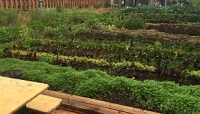How to contribute to Urban Prosperity through Reuse of PVC
At the 4th edition of the Vinyl Sustainability Forum, organised by VinylPlus, the sustainable development programme of the European PVC industry, a duo of Danish architects presented a project, sponsored by VinylPlus, on how the reuse of PVC building waste can contribute to efficient urban agriculture.
 The renowned Danish architect Kaare Sølvsten and newly graduated architect Maja Sønderskov presented to the 130 participants from academia, government bodies, the UN, the European Commission, specifiers, designers, architects and all sectors of the PVC industry, their vision on how the PVC material can contribute to solving the challenges of future cities.
The renowned Danish architect Kaare Sølvsten and newly graduated architect Maja Sønderskov presented to the 130 participants from academia, government bodies, the UN, the European Commission, specifiers, designers, architects and all sectors of the PVC industry, their vision on how the PVC material can contribute to solving the challenges of future cities.
Today the earth is facing climatic challenges, which suggest a potential change of mindset, behaviour and consumerist patterns. The growing population and increasing urbanization put pressure on existing food production and supply. The Food and Agriculture Organization of the United Nations (FAO) encourages urban agriculture, which provides nowadays fresh food, generates employment, recycles urban wastes, creates green belts and strengthens cities’ resilience to climate change (www.fao.org/urban-agriculture/en/).
Kaare and Maja are convinced that growing systems for urban agriculture can easily be made from PVC building waste such as pipes, gutters, cable covers and roofing sheets. PVC’s technical characteristics make the material a perfect choice for hydroponics, which is a water-based system where plants grow in a closed loop. This system saves both water and resources. The idea is simply to take advantage of the characteristics which are unique for PVC building applications. Indeed, end-of-life PVC building applications are light weight, water compatible, weatherproof, durable and readily available, and require low maintenance.
Maja Sønderskov highlights: “our project on sustainable urban agriculture can take place on different levels: private (balcony, kitchen, and stairways), municipal (intensive farming) and collective gardening. It presupposes a partnership between authorities, waste management department, housing associations, designers and architects, volunteers and local interest, and the local PVC industry. Everyone who wants to create a better future for our planet.”
Watch the video interview with Maja Sønderskov:

More information on “Reuse of PVC in Sustainable Urban Horticulture”

